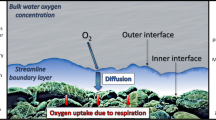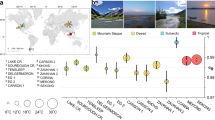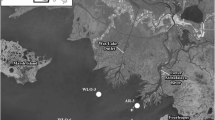Abstract
We estimated whole-ecosystem rates of respiration over a 40-km stretch of the tidally influenced freshwater Hudson River every 2 to 3 weeks from May through November. We measured in situ concentrations of oxygen over depth at dusk and dawn at 10 stations spaced over this interval. The use of multiple stations allowed for the consideration of the influence of tidal advection of water masses. Respiration was estimated from the decrease in oxygen overnight with a correction for diffusive exchange of oxygen with the atmosphere. We estimated this flux of oxygen to or from the atmosphere using the measured oxygen gradient and a transfer velocity model which is a function of wind velocity.
Integration of the data for the period of May through November yields an estimate of whole-ecosystem respiration of 591 g C m−2 (S.E. = 66). That the standard error of this estimate is relatively low (11% of the estimate) indicates that the use of multiple stations adequately deals with error introduced through the advection of water between stations. The logarithm of average daily respiration rate was correlated with average daily temperature (p = 0.007;r 2 = 0.62). We used this temperature-respiration relationship to derive an estimate of the annual respiration rate of 755 g C m−2 yr−1 (S.E. = 72). This estimate is moderately sensitive to the estimated flux of oxygen between the atmosphere and water; using the lower and upper 95% confidence limits of our model relating the transfer velocity of oxygen to wind speed gives a range of annual respiration estimates from 665 g C m−2 yr−1 to 984 g C m−2 yr−1.
The river is strongly heterotrophic, with most respiration driven by allochthonous inputs of organic matter from terrestrial ecosystems. The majority of the allochthonous inputs to the river (over 60%) are apparently metabolized within the river. Any change in allochthonous inputs due to changes in land use or climate patterns would be expected to alter the oxygen dynamics and energy flow within this tidally influenced river.
Similar content being viewed by others
References
Broecker WS & Peng TH (1974) Gas exchange rates between air and sea. Tellus 26: 21–35
Broecker WS, Peng TH, Mathieu G, Hesslein R & Torgersen T (1980) Gas exchange rate measurements in natural systems. Radiocarbon 22: 676–683
Cole JJ, Caraco NF & Peierls B (1991) Phytoplankton primary production in the tidal, freshwater Hudson River, New York (USA). Verh. Int. Ver. Limnol. 24: 1715–1719
Copeland BJ & Duffer WR (1964) Use of a clear plastic dome to measure gaseous diffusion rates in natural waters. Limnol. Oceanogr. 9: 494–499
Devol AH, Quay D, Richey JE & Martinelli LA (1987) The role of gas exchange in the inorganic carbon, oxygen, and222Rn budgets of the Amazon River. Limnol. Oceanogr. 32: 235–248
Edwards RW & Owens M (1962) The effects of plants on river conditions. IV. The oxygen balance of a chalk stream. J. Ecol. 50: 207–220
Esser G & Kohlmaier GH (1991) Modelling terrestrial sources of nitrogen, phosphorus, sulphur and organic carbon to rivers. In: Degens ET, Kempe S & Richey JE (Eds), Biogeochemistry of Major World Rivers (p 297–322). Wiley & Sons, Chichester, UK
Findlay S, Howe K & Austin HK (1990) Comparison of detritus dynamics in two tidal freshwater wetlands. Ecology 71: 288–295
Findlay S, Pace ML, Lints D, Cole JJ, Caraco NF & Peierls B (1991a) Weak coupling of bacterial and algal production in a heterotrophic ecosystem: The Hudson River estuary. Limnol. Oceanogr. 36: 268–278
Findlay S, Pace ML & Lints D (1991b) Variability transport of suspended sediments, particulate and dissolved organic carbon in the tidal freshwater Hudson River. Biogeochemistry 12: 149–169
Frankignoulle M (1988) Field measurements of air-sea CO2 exchange. Limnol. Oceanogr. 33: 313–322
Fruci JR & Howarth RW (1989) Carbon, nitrogen, and phosphorus loading to the Hudson River estuary from point and non-point sources: preliminary analyses. Technical report to the Hudson River Foundation, 40 West 20th St. New York, N.Y. 10011
Garritt RH (1990) The metabolism of a submersed macrophyte community in the tidal freshwater Hudson River estuary. Masters thesis, Cornell University, Ithaca, NY
Gladden JB, Cantelmo FR, Groom JM & Shapot R (1988) Evaluation of the Hudson River ecosystem in relation to the dynamics of fish populations. Amer. Fish. Soc. Mono. 4: 37–52
Hartman B & Hammond DE (1984) Gas exchange rates across the sediment-water and airwater interfaces in south San Francisco Bay. J. Geophys. Res. 89: 3593–3603
Howarth RW (submitted) Energy flow in salt marshes: a 20-year retrospective view. Estuaries
Howarth RW, Fruci JR & Sherman D (1991) Inputs of sediment and carbon to an estuarine ecosystem: influence of land use. Ecol. Appl. 1: 27–39
Ittekkot V, Safiullah S, Mycke B & Seifert R (1985) Organic matter in the River Ganges, Bangladesh: seasonal variablity and geochemical significance. Nature 332: 436–438
Ittekkot V & Arain R (1986) Nature of particulate organic matter in the River Indus, Pakistan. Geochim. Cosmochim. Acta 50: 1643–1653
Ittekkot V & Laane RWPM (1991) Fate of riverine particulate organic matter. In: Degens ET, Kempe S & Richey JE (Eds) Biogeochemistry of Major World Rivers (pp 233–243). Wiley & Sons, Chichester, UK
Jirka, GH & Brutsaert W (1984) Measurements of wind effects on water-side controlled gas exchange in riverine systems. In: Brutsaert W & Jirka GH (Eds) Gas Transfer at Water Surfaces (p 437–446). D. Reidel, Dordrecht
Kemp WM & Boynton WR (1980) Influence of biological and physical processes on dissolved oxygen dynamics in an estuarine system: implications for measurement of community metabolism. Est. Coast. Mar. Sci. 11: 407–431
Kempe S (1982) Long-term records of CO2 pressure fluctuations in fresh waters. Habilitationsschrift, Mitt. Geol.-Palaont. Inst. Univ. Hamburg 52: 91–332
Kempe S (1984) Sinks of the anthropogenically enhanced carbon cycle in surface fresh waters. J. Geophys. Res. 89. D3: 4657–4676
Kempe S, Pettine M & Gauwet G (1991) Biogeochemistry of European rivers. In: Degens ET Kempe S & Richey JE (Eds) Biogeochemistry of Major World Rivers (pp. 169–212). Wiley & Sons, Chichester, UK
Lehman JT & Maumoski T (1986) Net community production and hypolimnetic nutrient regeneration in a Michigan lake. Limnol. Oceanogr. 31: 788–797
Lewis WM (1988) Primary production in the Orinoco River. Ecology 69: 679–692
Limburg KE, Moran A & McDowell WH (1986) The Hudson River Ecosytem. Springer-Verlag, NY
Liss PS & Merlivat M (1986) Air-sea gas exchange rates: introduction and synthesis. In: Bu'at-Menard P (Ed) The Role of Air-Sea Exchange in Geochemical Cycling (pp. 113–127). D. Reidel, Boston
Marino R & Howarth RW (submitted) Atmospheric oxygen exchange in the Hudson River: dome measurements and comparison with other natural systems. Estuaries
Mearns AJ, Haines E, Klepple GS, McGrath RA, McLaughlin JA, Segar DA, Sharp JH, Walsh JJ, Word JQ, Young DK & Young MW (1982) Effects of nutrients and carbon loadings on communities and ecosystems. In: Mayer GF (Ed) Ecological stress and the New York Bight: Science and Management (pp 53–65). Estuarine Research Federation, Columbia, SC
Meybeck M (1982) Carbon, nitrogen, and phosphorus transport by world rivers. Am. J. Sci. 282: 401–450
Moore TR (1989) Dynamics of dissolved organic carbon in forested and disturbed catchments, Westland, New Zealand, 1. Maimai. Water Resources Res. 25: 1321–1330
Nixon SW & Oviatt CA (1972) Preliminary measurements of midsummer metabolism in beds of eelgrass,Zostera marina. Ecology 53: 150–153
Nixon SW, Oviatt CA & Buckley BA (1979) Turbulent mixing in marine microcosms — some relative measures and ecological consequences. In: Jacoff FS (Ed) Advances in Marine Environmental Research (pp 382–409). Report EPA-600/9-79-035, U.S. Environmental Protection Agency, Narragansett, RI
O'Connor DJ (1984) Turbulent transfer across smooth and rough surfaces. In: Brutsaert W & Jirka GH (Eds) Gas Transfer at Water Surfaces (pp. 321–331). D. Reidel, Dordrecht
Odum HT & Hoskins CM (1958) Comparative studies on the metabolism of marine waters. Publ. Inst. Mar. Sci. Texas 5: 16–46
Oviatt CA, Rudnick DT, Keller AA, Sampou PA & Almquist GT (1986) A comparison of system (O2 and CO2) and C14 measurements of metabolism of marine waters. Mar. Ecol. Prog. Ser. 28: 57–67
Richey JE, Devol AH, Hedges JI, Forsber BR, Victoria RL, Martinellis LA & Ribeiro N (1990) Distributions and flux of carbon in the Amazon River. Limnol. Oceanogr. 35: 352–371
Richey JE, Victoria RL, Salati E & Forsberg BR (1991) The biogeochemistry of a major river system: The Amazon case study. In: Degens ET, Kempe S & Richey JE (Eds) Biogeochemistry of Major World Rivers (pp 57–74). Wiley & Sons, Chichester, UK
Roberts PV (1984) Dependence of oxygen transfer rate on energy dissipation during surface aeration and in stream flow. In: Brutsaert W & Jirka GH (Eds) Gas Transfer at Water Surfaces (pp. 347–355). D. Reidel, Dordrecht
Roether W (1986) Field measurements of gas exchange. In: Burton JD, Brewer PG & Chesselet (Eds) Dynamic Processes in the Chemistry of the Upper Ocean (pp. 117–128). Plenum Press, NY
Roques P (1985) Anoxic nutrient regeneration and the eutrophication of estuarine waters. Ph. D. thesis, University of Rhode Island, Kingston, RI
SAS (1985). SAS User's Guide: Statistics, version 5 edition. SAS Institute Inc., Gary, NC
Schlesinger WH & Melack JM (1981) Transport of organic carbon in the world's rivers. Tellus 33: 172–187
Smethie WM, Takahashi T & Chipman DW (1985) Gas exchange and CO2 flux in the tropical Atlantic Ocean determined from222Rn and pCO2 measurements. Journal Geophys. Res. 90: 7005–7022
Spitzy A & Leenheer J (1991) Dissolved organic carbon in rivers. In: Degens ET, Kempe S & Richey JE (Eds) Biogeochemistry of Major World Rivers (pp 213–232). Wiley & Sons, Chichester, UK
Telang SA, Pocklington RA, Naidu S, Romankevich EA, Gitelson II & Gladyshev MI (1991) Carbon and mineral transport in major North American, Russian Arctic, and Siberian rivers: The St. Lawrence, the Mackenzie, the Yukon, the Arctic Alakan rivers, the Arctic basin rivers in the Soviet Union, and the Yenisei. In: Degens ET, Kempe S & Richey JE (Eds) Biogeochemistry of Major World Rivers (pp. 75–104). Wiley & Sons, Chichester, UK
Texas Instruments Incorporated Ecological Services (1976) A Synthesis of Available Data Pertaining to Major Physiochemical Varables Within the Hudson River Estuary. Consolidated Edison Company, New York, NY
Upstill-Goddard RC, Watson AJ, Liss PS & Liddicoat MI (1990) Gas transfer velocities in lakes measured with SF6. Tellus 42B3: 364–377
Vannote RL, Minshall GW, Cummins KW, Sedell JR & Cushing CE (1980) The river continuum concept. Can. J. Fish. Aquat. Sci. 37: 370–377
Wanninkhof R, Ledwell JR & Broecker WS (1985) Gas exchange-wind speed relation measured with sulfur hexaflouride on a lake. Science 227: 1124–1226
Author information
Authors and Affiliations
Rights and permissions
About this article
Cite this article
Howarth, R.W., Marino, R., Garritt, R. et al. Ecosystem respiration and organic carbon processing in a large, tidally influenced river: the Hudson River. Biogeochemistry 16, 83–102 (1992). https://doi.org/10.1007/BF00002826
Issue Date:
DOI: https://doi.org/10.1007/BF00002826




